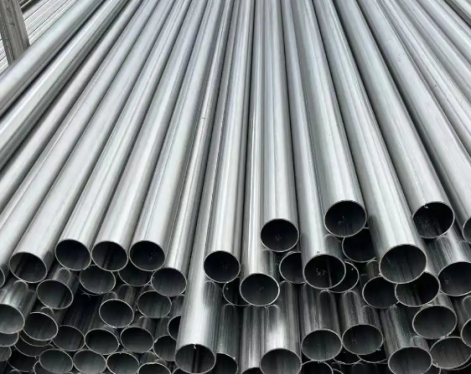Seamless steel pipes are round, square and rectangular hollow section steel pipes with no external joints. Seamless steel pipes are made of steel ingots or solid tube blanks through perforation into capillaries. Then it is made by hot rolling, cold rolling or cold drawing. Seamless steel pipes have a hollow section and are usually used as pipes for conveying fluids. Compared with solid steel such as round steel, steel pipes have the same bending and torsion strength and are lighter in weight. They are economical section steels and are widely used in the manufacture of structures, parts and mechanical parts, such as steel scaffolding for oil drilling.
ASTM A500 is a carbon steel cold-formed round section and special-shaped section welded square pipe and seamless square pipe for structural use.
Production process of seamless steel pipe
①The production process of hot-rolled seamless steel pipe:
Preparation and inspection of tube billet → heating of tube billet → piercing → tube rolling → reheating of waste tube → fixed (reduced) diameter → heat treatment → straightening of finished pipe → finishing → inspection (non-destructive, physical and chemical, bench inspection) → Warehousing.
②The production process of cold-rolled seamless steel pipe
Blank preparation → pickling and lubrication → cold rolling (stretching) → heat treatment → straightening → finishing → inspection.
Generally, seamless steel pipes are made of 10, 20, 30, 35, 45 and other carbon steels (such as 16Mn, 5MnV and other low alloy structural steels) or 40Cr, 30CrMnSi, 45Mn2, 40MnB and other composite steels. Seamless pipes made of low carbon steel, such as 10 and 20, are mainly used for fluid conveying pipelines. Seamless tubes made of medium carbon steel (such as 45 and 40Cr) are used to make mechanical parts. For example, the pressure parts of automobiles and tractors usually need to use seamless steel pipes for strength and flattening tests. Hot-rolled steel pipes are delivered in a hot-rolled or heat-treated state, and cold-rolled steel is delivered in a heat-treated state.
As the name implies, hot rolling is due to the high temperature of the rolled parts. Therefore, the deformation resistance is small and a large amount of deformation can be achieved. Taking steel plate rolling as an example, the thickness of the continuous casting slab is generally about 230mm, and the thickness after rough rolling and finishing rolling is 1-20mm. At the same time, due to the small width-to-thickness ratio of the steel plate, the dimensional accuracy requirements are relatively low, and shape problems are not prone to occur. The crown is mainly controlled. Usually, the structure is achieved by controlling the rolling and cooling, that is, controlling the initial rolling temperature of the finish rolling. Claim.
ASTM A500 is a carbon steel cold-formed round section and special-shaped section welded square pipe and seamless square pipe for structural use.
Production process of seamless steel pipe
①The production process of hot-rolled seamless steel pipe:
Preparation and inspection of tube billet → heating of tube billet → piercing → tube rolling → reheating of waste tube → fixed (reduced) diameter → heat treatment → straightening of finished pipe → finishing → inspection (non-destructive, physical and chemical, bench inspection) → Warehousing.
②The production process of cold-rolled seamless steel pipe
Blank preparation → pickling and lubrication → cold rolling (stretching) → heat treatment → straightening → finishing → inspection.
Generally, seamless steel pipes are made of 10, 20, 30, 35, 45 and other carbon steels (such as 16Mn, 5MnV and other low alloy structural steels) or 40Cr, 30CrMnSi, 45Mn2, 40MnB and other composite steels. Seamless pipes made of low carbon steel, such as 10 and 20, are mainly used for fluid conveying pipelines. Seamless tubes made of medium carbon steel (such as 45 and 40Cr) are used to make mechanical parts. For example, the pressure parts of automobiles and tractors usually need to use seamless steel pipes for strength and flattening tests. Hot-rolled steel pipes are delivered in a hot-rolled or heat-treated state, and cold-rolled steel is delivered in a heat-treated state.
As the name implies, hot rolling is due to the high temperature of the rolled parts. Therefore, the deformation resistance is small and a large amount of deformation can be achieved. Taking steel plate rolling as an example, the thickness of the continuous casting slab is generally about 230mm, and the thickness after rough rolling and finishing rolling is 1-20mm. At the same time, due to the small width-to-thickness ratio of the steel plate, the dimensional accuracy requirements are relatively low, and shape problems are not prone to occur. The crown is mainly controlled. Usually, the structure is achieved by controlling the rolling and cooling, that is, controlling the initial rolling temperature of the finish rolling. Claim.









